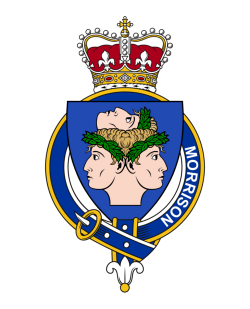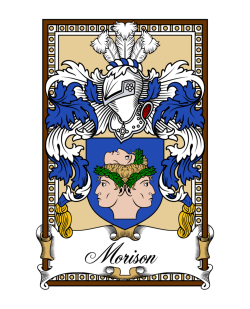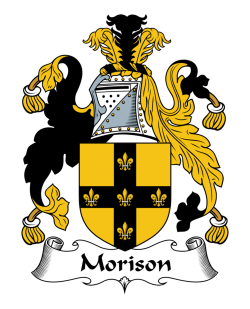
Clan Morrison
PABBAY
There are several individual families, both Highland and Lowland, with the surname morrison. In 1965 Lord Lyon King of Arms moved to recognise one man as chief of the clan Morrison, whether the families were related or not.
Ancient tradition says that once branch of the clan descended from a Norse family who were shipwrecked on the shores of Lewis. On the mainland, the Morrison clan descended from a Norman called Maurice (from who the name "Maurice's Son" became Morrison).
The Morrison clan motto is "Teaghlach Phabbay" (Family of Pabbay) and the clan crest is an arm and dagger rising from a wall.
Scottish History
of Clan Morrison
Laying down the law
They have made their mark on Scotland in particular and on the world in general in a variety of roles, ranging from judges, armourers and ministers to missionaries, rock stars, and film stars, and this very diversity of skill and talent can be explained by the fact that the Morrisons are thought to have sprung from three very different origins.
The chieftainship of the Clan Morrison is recognised as lying with the Morrisons of Ruchdi, on North Uist, who trace a descent back to the Morrisons of Lewis.
But who were these original Morrisons of Lewis? There are two quite separate traditions.
One is that a son of a Norwegian king was shipwrecked at sea and managed to survive the freezing waters of the Outer Hebrides by clinging for dear life to a piece of driftwood.
He was washed up on the shores of Lewis, where he settled, known under the Gaelic name of Ghille Mhuire – ‘Servant of Mary’, or ‘Servant of the Virgin Mary’.
Also known as the ‘Devotees of Mary’, the clan of Ghille Mhuire later were known under the anglicised form of ‘Morrison’, or ‘Morison’, and claim a Scandinavian descent from their original shipwrecked ancestor.
The clan ‘plant’, or emblem, of a piece of driftwood commemorates this origin.
Morrisons also claim a descent from a family of O’Muirgheasains, from Inshowen, in County Donegal, Ireland, who settled on Lewis at an undetermined date.
Morrisons claiming a descent from the Hebridean Morrisons also found a home on the northwest mainland of Scotland, while an unrelated family of Morrisons, known as ‘the sons of Maurice’ held territory in Perthshire and Aberdeenshire.
Derived from the Latin ‘Mauricius’, meaning swarthy, or dark-skinned, Maurice was a name popularised in both England and Scotland by those Normans who settled there following the Norman Conquest of 1066.
The genealogy of the Hebridean Morrisons is understandably tangled when we realise that the original O’Muirgheasains and the original clan of Ghille Mhuire intermarried.
Their history is also intertwined with neighbouring clans such as the MacDonald Lords of the Isles, the Macleods, the MacAulays, the Gows, and the Mackenzies.
It was under the Macleods that the Morrisons held Habost, in the north of Lewis, and the ancient hereditary office of brilheanh. This was the office of brieve, or ‘one who sits in judgement’, and is known to have been held by the Morrisons by at least the late 13th century.
It is reasonable to assume that this important office of trust had first been conferred on those Morrisons who trace a descent from the O’Muirgheasains who originally came from Ireland, because this family is known to have been renowned as bards.
Bards were not simply clansmen who entertained the rest of the clan with songs and poetry, but were the custodians of the clan’s history and traditions.
This ancient Celtic institution stretched back to the time of the Druids, when the bards formed an elite within the clan structure, along with those skilled in what were considered the arcane arts of medicine and astronomy.
This educated elite of O’Muirgheasain bards, trained in the skills of gathering, analysing, and retaining aspects of ancient clan lore and customs, may well have been the forerunners of those Morrisons who became trusted with the office of brieve, or ‘law-giver’. The tradition of brieve, or demester, also closely corresponded with a similar Scandinavian tradition.
The first recorded anglicised form of ‘Morrison’ occurs in the 16th century, in relation to Uisdean (Hugh) the Brieve, a contemporary of Roderick Macleod, chief of the Macleods of Lewis from 1532 until 1595.
Hugh is said to have treacherously betrayed Torquil Dubh Macleod to the rival Mackenzies, who beheaded him in 1597.
A descendant of those Morrisons whose ancestor was the son of a Norwegian king settled at Pabbay, in Harris, where they became noted smiths and armourers.
Some sources claim they were armourers to the Macleods, while others note they may have been armourers to the Gows.
The Morrisons of Ruchdi, on North Uist, are descendants of these Pabbay Morrisons, and that is why the chieftainship of the clan is invested in them and why ‘Pabbay’ is the clan motto.
In common with the brieves, smiths and armourers were accorded great respect because of the importance of their skilled work – particularly during times of turbulent clan warfare when the outcome of a battle could rest on the quantity and quality of artfully forged weapons a clan could bring to the place of battle.
The power of the Morrisons increased in 1346 when Cedhain, a relation of the mighty MacDonald Lords of the Isles, married the heiress of a Morrison of Lewis, but the succeeding centuries saw their power and influence dramatically wane as not only rival clans but the power of the mainland monarch brought internecine and bloody warfare to the Hebrides.
Letters of fire & sword
It was during the reign of James VI that in 1597 an Act of Parliament was passed to suppress what was considered to be the ‘barbarous inhumanity’ of Highlanders and Islanders.
The monarch, certainly no friend of his far flung western seaboard and northern subjects, accordingly issued what were known as Letters of Fire and Sword to bring the unruly clansmen to heel.
In what became known as the Daunting of the Isles, Lewis was signalled out for special attention in a campaign that would today be described as a form of ethnic cleansing.
Seeking to justify the savage attack to be launched on the islanders, the Privy Council condemned ‘the beastly and monstrous cruelties’ that the islanders inflicted upon one another, and pointed out that the rich and fertile lands of Lewis would be better managed by others.
The unruly Lewismen, the Privy Council complained, were possessed with ‘the most fertile and commodious part of the whole realm … being enriched with incredible fertility of corns and plenty of fish.’
Accordingly, in 1598, James VI issued a charter, or contract, to a band of speculators who became known as the Fife Adventurers.
Backed by a 600-strong force of mercenaries led by the Duke of Lennox, the adventurers attempted to wipe out the inhabitants of Lewis and take their lands for themselves.
They received a rude shock, however, when a hardy band of inhabitants led by Neil Macleod, a brother of a Macleod clan chief, fought back with such ferocity that the dismayed mercenaries described them as ‘barbarous, bloody, and wicked Hielandmen.’
One of the Fife Adventurers was captured and ransomed, only to die from the privations he had suffered during his captivity.
The adventurers withdrew and another force was later sent to renew the attempt at bringing the clansmen to heel, but this also proved abortive.
Mackenzie of Kintail had offered his support to the Privy Council because he wished to take advantage of the downfall of the rival MacLeods, and through the confused loyalties of the time, the Morrisons had sided with the Mackenzies.
This had come about after it was discovered that Torquil Macleod, who had been accepted as the heir to the Macleod chief, was actually the bastard son of a Morrison.
Torquil was immediately disinherited by the Macleods and allied himself with the Morrisons in support of the Mackenzies.
When Mackenzie of Kintail eventually succeeded in buying up the charters the king had granted to the adventurers and imposed his control on Lewis, however, the only reward the Morrisons received for their support was to be driven from their lands.
It is from about this date that the Morrisons ceased to be the hereditary brieves of Lewis.
A number of Morrison families fled Lewis and eventually settled in the Mackay lands, in Sutherland, and this is said to explain why the Morrisons and Mackay tartans closely resemble one another.
Other Morrisons found refuge with the Macleans of Duart, on Skye.
Neil Macleod, who had bravely attempted to resist the subjugation of his lands, was also forced to flee the island. He became a pirate, roaming the western seaboard, but was captured and hanged in 1613, one account noting that he died ‘very Christian-like’ on the scaffold.
Further desperate attempts were made to stamp the authority of the Crown on the Highlands and Islands through the Statutes of Iona of 1609 and parallel legislation in 1616.
The Morrisons were among the many clans that suffered from this attempt to impose Lowland standards on their ancient way of life.
Bards were to be treated in the same manner as beggars, and likely to have their ears cut off and banished – facing death by hanging if they returned.
Attempts were also made to replace the Gaelic language with English and the translation of the Bible into Gaelic was banned.
It was also required that the eldest son or daughter of every clan chief or ‘gentleman’ who owned goods worth 60 cattle or more should be educated in the Lowlands.
An attempt was also made to ‘plant’ Lowland cultivators on the lands of those chiefs who failed to produce written proof of the right to hold their lands. This proved disastrous, however, and the scheme was abandoned.
Strict controls were enforced on the distilling of whisky to prevent its illegal sale. The ordinary man was allowed to distil whisky, but only in his own home and for his own use.
It was at some stage in the early 17th century that the Morrisons of Pabbay are believed to have been forced off their lands for illegally distilling this ‘usquebagh’, the ‘water of life.’
Through an Act passed in 1616, the ordinary man and woman was also banned from drinking wine, the government of the day deeming that its reckless consumption was largely responsible for the poverty and lawlessness then prevalent in the Highlands and Islands.
In a passage reminiscent of Compton Mackenzie’s Whisky Galore, the preamble to the Act depicts the reaction of the islemen such as the Morrisons and their neighbours to the arrival of vessels bearing not whisky, but wine.
It describes how ‘with the insatiable desire thereof the said inhabitants are so far possessed, that when there arrives any ship or other vessel with wines, they spend both days and nights in their excess of drinking so long as there is any of the wine retained; so that, being overcome with drink, there falls out many inconvenients among them.’
Although clan chiefs were allowed to enjoy fine wines, imported mainly from France, restrictions were imposed on exactly how much their household was allowed to consume.
They were also only allowed to buy from Lowland merchants, with the imposition of fines for breaking the restrictions.
This was aimed at stamping out a lucrative smuggling trade, but with Scotland’s western seaboard boasting thousands of tiny harbours and coves this proved almost impossible.
The higher the rank, or standing, of the chief, the higher the ration of precious wine he was allowed.
MacLean of Duart, Macleod of Dunvegan, and Donald Gorme of Sleat were allowed four tuns – or sixteen hogsheads – a year, while the captain of Clanranald was restricted to three tuns – or twelve hogsheads a year.
A hogshead was roughly equivalent to 219 imperial gallons.
Other measures adopted to pacify the restless Morrisons and their neighbours included an obligation on the part of clan chiefs to provide inns, or hostels, for the traveller, a ban on carrying pistols unless on government service, provision for clergy to be ‘paid and obeyed’ and churches rebuilt.
The practice of ‘sorning’, extracting free board and lodging from the poor, was to be treated as the equivalent of theft, while no chief was to be allowed to own more than one birling, or galley, of 16 or 18 oars, while they were also required to have a fixed residence.
Clan chiefs were also required to produce written documentation of the right to their titles, a task that often proved impossible for many chiefs whose rights rested not on the written word, but on ancient custom and practice.
All these measures combined to erode not only the authority of the clan chiefs in particular but the entire way of life of islemen such as the Morrisons.
In common with their neighbours many had no option but to adapt to the changing times and seek a new life elsewhere.
Family History Mini Book
We hope you enjoyed reading this excerpt from this mini book on the Scottish history of the Morrison family.
You can buy the full book for only113 Clan Morrison
Tartan Products
The Crests
of Clan Morrison






































































